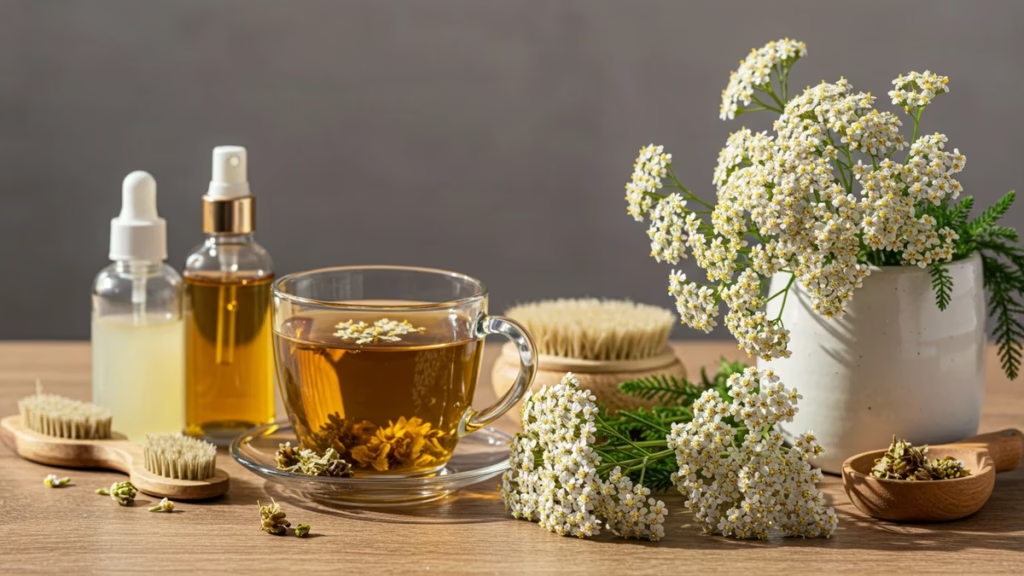Introduction
Yarrow (Achillea millefolium) is one of the most celebrated medicinal herbs with a history that stretches back thousands of years. Ancient civilizations used it for wound healing, digestive health, and balancing the body. Today, research continues to uncover the many yarrow benefits for modern wellness.
If you are curious about what this traditional plant can do for your health, this detailed guide will cover its uses, nutrition, potential side effects, and how you can incorporate it into your lifestyle.
What Is Yarrow?
Yarrow is a flowering plant that belongs to the Asteraceae family, the same group as chamomile, daisies, and sunflowers. Known for its delicate white flowers and feathery leaves, it grows abundantly across North America, Europe, and Asia.
- Botanical Name: Achillea millefolium
- Other Names: Soldier’s Woundwort, Bloodwort, Nosebleed Plant, Old Man’s Pepper
- Parts Used: Leaves, flowers, and stems
- Traditional Uses: Stopping bleeding, easing menstrual discomfort, supporting digestion, calming the nervous system
Nutritional Profile of Yarrow
Yarrow is not just a folk remedy—it contains active compounds that explain its therapeutic effects. Some of the key constituents include:
- Flavonoids – antioxidant compounds that help fight free radicals
- Tannins – astringent agents that support wound healing
- Volatile oils (chamazulene, cineole, camphor) – anti-inflammatory and antimicrobial properties
- Sesquiterpene lactones – bioactive compounds with immune-modulating benefits
- Salicylic acid – naturally found, works similar to aspirin for pain relief
These compounds make yarrow a powerhouse for natural health remedies.
Top Yarrow Benefits for Health
1. Supports Wound Healing
One of the oldest recorded uses of yarrow is for wound care. Soldiers in ancient times carried yarrow to stop bleeding quickly—earning it the nickname “soldier’s herb.”
- Yarrow’s tannins help constrict tissues and reduce bleeding.
- Its antimicrobial oils may lower the risk of infection.
- Applied topically as a poultice or salve, yarrow can speed up the recovery process.
2. Eases Digestive Issues
Yarrow has long been used as a digestive tonic. It can help with:
- Bloating and gas – by stimulating bile flow
- Indigestion – due to its bitter compounds
- Stomach cramps – thanks to its antispasmodic effects
A cup of yarrow tea before meals is often recommended for mild digestive discomfort.
3. Menstrual Support and Hormonal Balance
For centuries, women have used yarrow to regulate menstrual cycles and ease period pain.
- Yarrow’s antispasmodic and anti-inflammatory compounds help relax the uterus and reduce cramps.
- It may also support hormonal balance, making cycles more regular.
- Some traditional practitioners use it for symptoms of menopause like hot flashes and mood swings.
4. Anti-Inflammatory Properties
Chronic inflammation contributes to conditions like arthritis, heart disease, and digestive issues. Yarrow’s flavonoids and sesquiterpene lactones have been shown to reduce inflammatory responses, making it beneficial for:
- Joint pain and stiffness
- Muscle soreness
- Inflammatory skin conditions like eczema
5. Boosts Immune System
Yarrow has a natural ability to stimulate the immune system.
- Its antimicrobial oils help fight bacteria and viruses.
- Antioxidants in yarrow may strengthen your body’s defenses against infections.
- Herbalists often recommend it for colds, flu, and fevers.
6. Supports Skin Health
Yarrow is increasingly popular in natural skincare.
- Its antiseptic properties make it useful for acne-prone skin.
- Yarrow-infused oils and creams can soothe irritation, dryness, and redness.
- Traditionally, yarrow baths were used to relieve eczema and rashes.
7. Calms Anxiety and Improves Sleep
Another valuable benefit of yarrow is its calming effect on the nervous system.
- Drinking yarrow tea may help reduce stress and anxiety.
- Its mild sedative qualities make it a natural sleep aid.
- It pairs well with herbs like chamomile and lemon balm for relaxation.
8. Cardiovascular Support
Preliminary studies suggest that yarrow may benefit heart health by:
- Reducing blood pressure due to its vasodilating effect
- Improving circulation by relaxing blood vessels
- Supporting healthy cholesterol levels
This makes yarrow a potential ally in maintaining overall cardiovascular wellness.
Different Ways to Use Yarrow
There are many forms in which you can enjoy the benefits of yarrow:
- Yarrow Tea – Made from dried flowers and leaves; excellent for digestion, stress, and immunity.
- Tincture – A concentrated liquid extract; commonly used for menstrual health and digestion.
- Poultice or Salve – Crushed leaves applied to wounds, cuts, or bruises.
- Essential Oil – Used in aromatherapy and skincare products.
- Capsules or Supplements – For consistent dosing under professional guidance.
Possible Side Effects and Precautions
While yarrow offers many benefits, it should be used carefully:
- Allergic Reactions: People allergic to plants in the Asteraceae family (daisy, ragweed, marigold) may react to yarrow.
- Pregnancy and Breastfeeding: Yarrow is not recommended during pregnancy, as it may stimulate uterine contractions.
- Drug Interactions: It may interfere with blood thinners, blood pressure medications, and sedatives.
- Skin Sensitivity: Direct application can cause irritation in sensitive individuals.
👉 Always consult a healthcare provider before starting yarrow, especially if you’re on medication.
Yarrow vs. Other Herbs
How does yarrow compare to other healing herbs?
| Herb | Main Benefits | Best Uses |
|---|---|---|
| Yarrow | Wound healing, menstrual support, digestive aid | Cuts, cramps, anxiety |
| Chamomile | Relaxation, digestive soothing | Stress relief, upset stomach |
| Peppermint | Cooling, digestive health | Bloating, headaches |
| Echinacea | Immune booster | Cold and flu prevention |
This comparison highlights why yarrow benefits stand out in traditional and modern herbal medicine.
How to Grow and Harvest Yarrow
If you want fresh access to this herb, growing yarrow is simple:
- Soil: Well-drained, sandy soil
- Sunlight: Full sun to partial shade
- Harvesting: Cut flowers and leaves in mid-summer when blooms are at their peak
- Drying: Hang upside down in a warm, dark place for later use
Conclusion
Yarrow has stood the test of time as a powerful natural remedy for wounds, digestion, women’s health, and much more. With its wide range of therapeutic properties, this ancient herb continues to prove its worth in modern wellness practices.
If you are looking for a gentle yet effective herbal ally, yarrow may be the perfect addition to your natural health toolkit.







